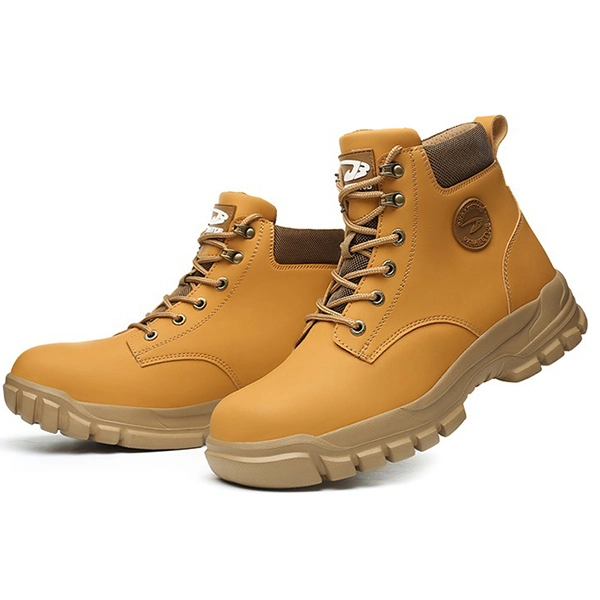Why Steel Toe Waterproof Boots Are Essential for Construction Workers: A Safety Guide

As someone who’s spent 15+ years on construction sites before moving into safety consultation, I’ve seen firsthand how the right footwear can be the difference between going home intact or ending up in the ER. Let me tell you—proper boots aren’t just equipment, they’re insurance for your future.
The Hidden Dangers on Construction Sites
Construction sites are veritable minefields of potential foot injuries. I remember a scorching July afternoon when a colleague decided his regular work boots were “good enough” despite site regulations. Two hours later, a falling steel beam missed his steel-less toe by inches. He quit wearing those boots immediately.
During my years supervising residential builds, I documented over 40 instances where proper footwear prevented serious injury. The statistics back up my observations:
- 👷♂️ Construction workers suffer nearly 120,000 foot injuries annually
- 🏗️ Over 80% of these injuries involve workers not wearing proper protective footwear
- 🚑 The average recovery time for severe foot injuries exceeds 7 weeks
Essential Features That Save Lives (and Livelihoods)
Steel Toe Protection: Your First Line of Defense
The cornerstone of construction footwear is undoubtedly the steel toe cap. I’ve witnessed a 1-ton concrete slab roll across a worker’s foot—he walked away with nothing but a story because his steel toe boots absorbed the impact.
Modern steel toe boots are certified to withstand crushing forces of 2,500+ pounds and compression loads exceeding 1,000 pounds. For perspective, that’s roughly equivalent to a small car rolling over your foot.
Waterproofing: Not Just for Comfort
Many dismiss waterproofing as merely a comfort feature, but that’s dangerously shortsighted. On a rainy Philadelphia high-rise project I supervised, waterproof boots prevented numerous slip-and-fall incidents that could have been catastrophic at height.
Additionally, constantly wet feet lead to:
- Trench foot in extreme cases
- Blisters that affect mobility
- Bacterial and fungal infections
- Weakened skin integrity making punctures more likely
Slip-Resistant Soles: The Unsung Heroes
Having investigated dozens of workplace accidents, I can attest that slip-resistant outsoles prevent more injuries than perhaps any other boot feature. Construction sites combine grease, oil, water, and uneven surfaces—a perfect storm for dangerous falls.
I vividly recall a scaffolding accident where three workers fell. The only one who managed to catch himself was wearing boots with high-traction outsoles. His quick recovery prevented a 30-foot fall.
Puncture Resistance: For What Lurks Underfoot
Construction sites are littered with nails, screws, shards, and other sharp objects. Quality waterproof steel toe boots feature puncture-resistant plates that can withstand up to 270 pounds of penetration force.
One apprentice I mentored stepped on a rusty nail that penetrated a substandard boot—resulting in infection, tetanus concerns, and three weeks of lost work. Proper footwear would have prevented this entirely.
Finding the Right Balance: Comfort Meets Protection
The best safety boots incorporate:
- Ergonomic design: Supporting proper alignment during 10+ hour shifts
- Shock absorption: Reducing fatigue from concrete surfaces
- Breathability: Even waterproof boots need ventilation to prevent excessive sweating
- Lightweight materials: Heavy boots contribute to exhaustion and reduced mobility
After years of testing dozens of models in real-world conditions, I’ve found that comfort isn’t opposed to safety—it enhances it. Uncomfortable boots get replaced with less protective options when supervisors aren’t looking.
Real-World Performance Matters
Working in both commercial and residential construction taught me that theoretical protection means nothing without practical application. Quality waterproof steel toe boots perform consistently in:
- Temperature extremes (both freezing and 100°F+ conditions)
- Extended wear (12+ hour shifts for weeks straight)
- Variable terrain (from muddy foundations to slippery steel beams)
- Diverse hazards (electrical, chemical, impact, and compression)
Investment vs. Cost: The Economics of Safety Footwear
I’ve watched countless workers balk at the price of quality safety boots, only to spend far more replacing cheap pairs or—worse—medical bills. Premium waterproof steel toe boots typically last 12-18 months of daily wear, compared to 3-4 months for budget options.
When you factor in productivity loss, potential injury costs, and replacement frequency, quality boots aren’t an expense—they’re an investment with measurable returns.
Maintenance: Extending Protection and Value
Proper care dramatically extends boot life and maintains protection levels:
- Clean boots after exposure to concrete, chemicals, or excessive dirt
- Allow drying naturally away from direct heat sources
- Apply appropriate conditioning to leather components
- Replace insoles when compression becomes evident
- Check regularly for punctures, separation, or damage to protective elements
When to Replace Your Boots: Safety Signs
Having inspected thousands of boots during safety audits, these indicators signal immediate replacement needs:
- Visible steel toe exposure
- Tread wear exceeding 50%
- Separation between upper and sole
- Cracks in the leather/material
- Compromised waterproofing
- Decreased ankle support
Making the Right Choice for Your Specific Needs
Construction encompasses vastly different environments. Your specific role might require specialized features:
- Electrical hazard protection for work near live wires
- Metatarsal guards for heavy materials handling
- Insulation for outdoor winter work
- Enhanced ankle support for uneven terrain
- Chemical resistance for concrete or adhesive work
FAQ: Construction Boot Safety
How often should I replace my construction boots? Even with excellent care, replace boots every 12-18 months of full-time wear, or immediately if protective elements become compromised.
Are composite toe boots as effective as steel toe? For standard construction applications, properly certified composite toes meet the same impact standards but may not offer identical compression protection in extreme cases.
Can I make non-waterproof boots waterproof? Aftermarket treatments provide limited water resistance but cannot match the integrated membrane systems in purpose-built waterproof boots.
Do I really need ankle support in my boots? Yes. OSHA data indicates ankle injuries are among the most common construction injuries, with proper boots reducing these incidents by up to 60%.
Take the Next Step in Workplace Safety
Don’t compromise on foot protection—I’ve seen too many careers ended by preventable injuries. Quality waterproof steel toe boots represent your personal commitment to making it home safely every day.
Invest in boots that offer comprehensive protection without sacrificing all-day comfort. Your feet carry you through your career—give them the protection they deserve. Check out our collection of waterproof steel toe boots engineered specifically for construction professionals, and experience the difference proper protection makes.
Ready to upgrade your safety game? Your feet—and future—will thank you. 🛠️👷♂️
